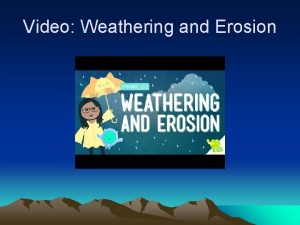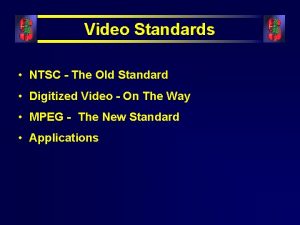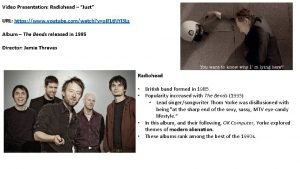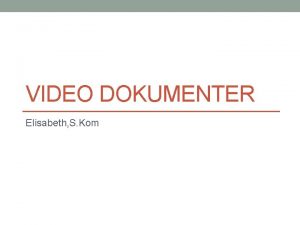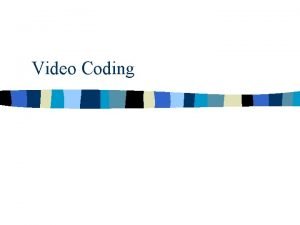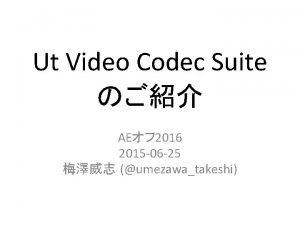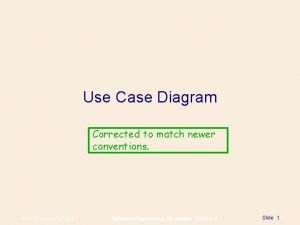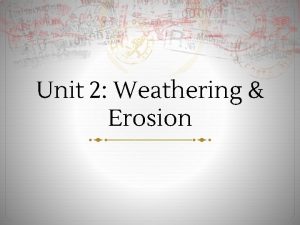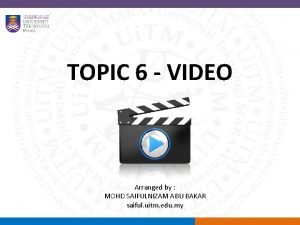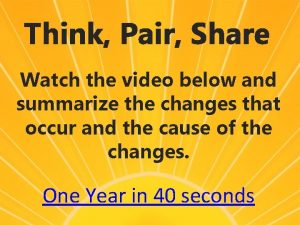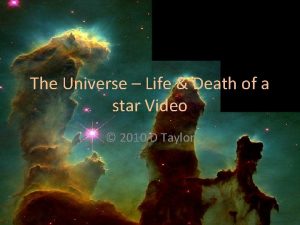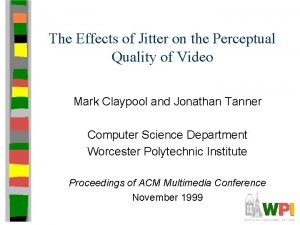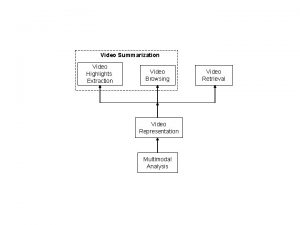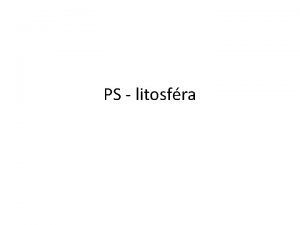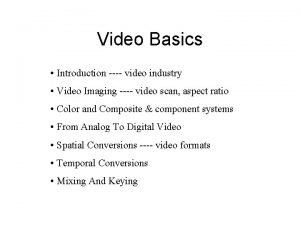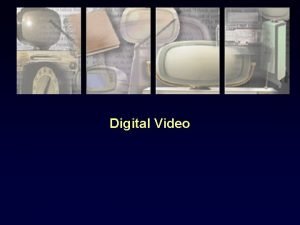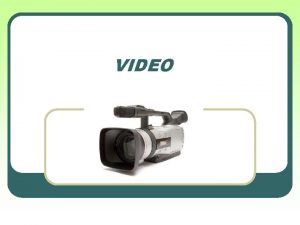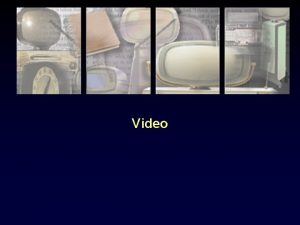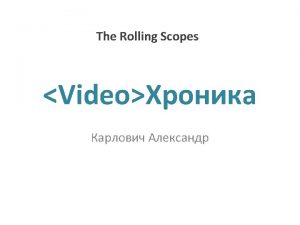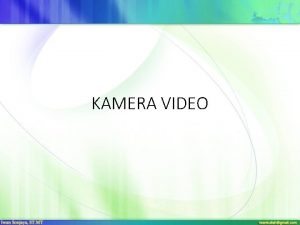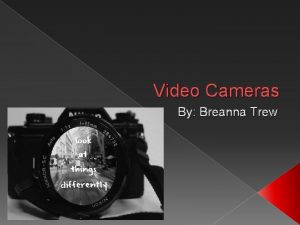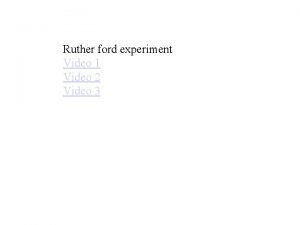Video Chapter 7 What is Video Video is

















































- Slides: 49

Video Chapter 7

What is Video? Video is when you take many pictures per second, sequence the pictures in order, and play them back at about the same rate as they were taken. p Animation is different. p n n Typically, you take or make the pictures at a much slower rate but then play them back at a faster rate. Not live, not real-time.

Video Recording p The technology for recording video is pretty much the same as the technology for taking pictures n p How to store it n n p Optical device that can capture a scene (the actual light) and store it. Negative film (analog) Digital encoding (requires codec) The challenge is that video requires taking and storing many picture per second.

Movie Cameras vs. Camcorder Movie Cameras stores images on negative film. p Mechanical – moving parts p Optical – glass lenses p Analog – no bits needed Camcorder stores images on magnetic tape. p Still mechanical – to move tape p Same optical technology as any camera p Analog capture but images stored digitally (requires a codec).

Analog vs. Digital Q: Are camcorders analog or digital? p A: They are both p They process analog signals (light and sound waves) p At some point the signals are digitally encoded. p Magnetic Tapes Bit encoding p Negative Film No bits, real image p

Alternative to Magnetic Tapes As Flash memory chips get bigger, they will likely replace tapes. p Also, camcorders may eventually have Hard Disks similar to the 20 GB+ i. Pods. p Tapes are still more cost effective for recording/archiving. p Tapes are sequential, no random access. p

Recording is driven by Broadcast p The way video is recorded/stored is dictated by how it is Broadcast. n Specifically, TV Broadcast refers to how the signal is transmitted to the masses. p Ultimately, dictated by p n n What kind of TV’s people have Cable TV systems

PAL p Is an Analog Video Standard for Broadcast TV p Phase Alternating Line is a color encoding system used in broadcast television in large parts of the world (Most of Europe) Other common television systems are SECAM and NTSC. p

NTSC National Television System Committee p Analog television system used in USA, Canada, Japan, Mexico, the Philippines, South Korea, and Taiwan. p

191– 192 PAL (Digital Specifications) p Minimal Resolution n 768 x 576 pixels per frame p p Minimal Sampling n p x 25 frames per second Uncompressed Size n n p x 3 bytes per pixel (24 bit colour) ≈ 31 MB per second ≈ 1. 85 GB per minute Compressed Size

191– 192 NTSC (Digital Specifications) p Minimal Resolution n 640 x 480 pixels per frame p p Minimal Sampling n p x 30 frames per second (approx) Uncompressed Size n n p x 3 bytes per pixel (24 bit colour) ≈ 26 MB per second ≈ 1. 6 GB per minute Compressed Size n n ≈ 4 MB per minute ≈ 240 MB per minute

Camcorders revised… p The term camcorder is combination of n p Camera + Tape Recorder VHS and Beta were the initial standard n n VHS won. Similar to Blu-ray vs. HD DVD Long before VHS recorders were marketed to the end consumer p VHS camcorders and devices were pioneered by the TV news market. p

The New Camcorders DV and Mini. DV - Same thing as VHS but p Physically smaller tape n p More storage capacity n p Recorders are smaller Higher resolution video Faster encoding n n More frames per second Less noise

DV and Mini. DV p p Intended for consumer market as a high-quality replacement for VHS Camcorders But, L-size DV cassettes are primarily used in professional settings n Standard for TV News p Mini DV Camcorders are becoming consumer standard. p I requested a Mini. DV for this course but was denied.

DV and Mini. DV p The "L" cassette n p The better known Mini. DV "S" cassettes n p 60 or 90 minutes of video (11 GB) Terminology n n p 4. 6 hours of video Standard Play (SP) Extended Play (sometimes called Long Play) (EP/LP). Mini-DV Tapes are about $3. 00 each

DVCPRO p Panasonic created DVCPRO for electronic news gathering. n n p p Higher resolution and more frames per second compared to DV standard Better linear editing capabilities and robustness. DVCPRO HD, also known as DVCPRO 100 can capture video at 1440 x 1080 up to 60 frame per second. "M" tape can only hold up to 66 minutes of video.

HD Digital Movies Most major motion pictures are shot in negative film (analog technology) p Film negative is high resolving medium (as good as the best digital capturing technology) p n n n Academy camera US Widescreen: p 21 × 11 mm 2970 × 1605 Current Anamorphic Panavision ("Scope"): p 21 × 17. 5 mm 2970 × 2485 Super-35 for Anamorphic prints: p 24 x 10 mm 3390 × 1420

How Film Works p Film has millions of light-sensitive silver halide crystals (silver + halogen) n p p p held together in a cubical arrangement by electrical attraction. When crystals are struck by light, silver ions build up a collection of uncharged atoms. These ions, too small to even be visible under a microscope, are the beginning of a latent image. Developing chemicals use the latent image specs to build up density, an accumulation of enough metallic silver to create a visible image

Film Width p p p Each image stored sequentially on film role. To achieve higher resolution, you can increase the width of the film Only part of the width can be used to capture images 35 mm 21 mm

Film Width & Orientation 35 mm Film can achieve High Definite (HD) resolutions p HD Wide Screen 1920+ × 1080+ p 70 mm can go way beyond the HD seen on Blu. Ray and HD DVD. p IMAX used 70 mm film and changes the orientation. p 10000 X 7000 is possible. p

Digitizing Film Converting the Film (analog) to digital form. p Negative Film Scanners are used… p Prices range from $100 to $20, 000 p http: //www. ephotozine. com/article/Plustek -Optic. Film-7200 i p

Recap p Video standards are driven by what can be viewed or Broadcast. n Broadcast standard in US is NTSC 640 X 480. Magnet Tape is still the most cost-effective technology for storing digital video. p Improvements in viewing Technology: Affordable HD TV’s, DVD’s, Bluray, etc. have lead to… p n n DV, Mini. DV, and DVCPro recorders and tapes DVCPro HD 1440 x 1080

Recap p Negative Film (analog) is still superior to digital alternatives in terms of n n p Maximum Resolution Frame rate However, for production, negative film is often digitized using film scanners. n n Digital video is easier to edit. Digital signals have no noise. p Analog signals can be corrupted when transmitted over distances. Negative film can also be easily damaged.

Another example of Multimedia p http: //www. cia. edu/dreams/surreal/index 1. html

197 Streamed Video Play back a video stream as it arrives over a network (like broadcast TV), instead of downloading an entire video clip and playing it from disk (like renting a DVD) p Example: you. Tube p

198 HTTP Streaming Start playing a downloaded clip as soon as enough of it has arrived p Starts when the (estimated) time to download the rest is equal to the duration of the clip p

Ideal Streaming Systems Ideally, several different versions could be available p Your system (web browser, etc. ) download that largest version that it can play in realtime. p n n Starts immediately Downloads entirely before its over Requires knowledge of you network performance, which could change p Pipe Dream of sorts. p

200 Interlacing Required for TV signal; Capitalizes on features of CRT technology. p Each frame is divided into two fields p Field 1: odd lines; Field 2: even lines p Fields are transmitted one after the other p Frame is built out of the interlaced fields p http: //en. wikipedia. org/wiki/Interlace p

Chrominance p Chrominance (chroma for short), is the signal used to carry the color information separately from the accompanying luma signal. n n p Chroma is color Luma is brightness Chrominance has two color difference components: n n B'–Y' (blue – luma) R'–Y' (red – luma)

Chrominance Separating RGB color signals into luma and chroma values has many advantages p First, in B&W CRT’s can display only the luma values, which gives you the grayscale component. p Second, the human eye is more sensitive to luma then chroma, so you don’t have to transmit the chroma signal for all pixels. p

203 4: 2: 2 sub-sampling p Twice as many luma samples as each of chroma samples p Normally, there would be three signals (dots) for every pixel. p How, many dots per pixel are here? (on averge).

210 DV sub-sampling p PAL DV 4: 2: 0 chrominance subsampling

210 DV sub-sampling p NTSC DV 4: 1: 1 chrominance subsampling

204– 206 MPEG ISO/IEC Motion Picture Experts Group p Series of standards including p n n n MPEG-1 intended for video CD MPEG-2 used in DVD and broadcast MPEG-4 for low bitrate multimedia

204– 205 MPEG Profiles & Levels Profiles define subsets of the features of the data stream p Levels define parameters such as frame size and data rate p Each profile may be implemented at one or more levels p Notation: profile@level, e. g. MP@ML p http: //en. wikipedia. org/wiki/MPEG 4_Part_2#Profiles p

205 MPEG-2 Profiles & Levels p MPEG-2 Main Profile at Main Level (MP@ML) used for DVD video n n n CCIR 601 scanning Interlaced 4: 2: 0 chrominance sub-sampling 15 Mbits per second

205– 206 MPEG-4 Designed to support a range of multimedia data at bit rates from 10 kbps to >1. 8 Mbps p Applications from mobile phones to HDTV p Video codec becoming popular for Internet use, is incorporated in Quick. Time, Real. Media and Div. X p

205 MPEG-4 Profiles & Levels Visual Simple Profile (SP), suitable for low bandwidth streaming over Internet p Visual Advanced Simple Profile (ASP) suitable for broadband streaming p SP@L 1 (Level 1 of Simple Profile), 64 kbps, 176 x 144 pixel frame p ASP@L 5, 8000 kbps, full CCIR 601 frame p

206– 208 Video Compression p Spatial (intra-frame) compression n p Temporal (inter-frame) compression n p Compress each frame in isolation, treating it as a bitmapped image Compress sequences of frames by only storing differences between them Always some compression because of sub-sampling

207 Spatial Compression Image compression applied to each frame p Can therefore be lossless or lossy, but lossless rarely produces sufficiently high compression ratios for volume of data p Lossless compression implies a loss of quality if decompressed then recompressed p Ideally, work with uncompressed video during post-production p

207– 208 Temporal Compression p Key frames are spatially compressed only n Key frames often regularly spaced (e. g. every 12 frames) Difference frames only store the differences between the frame and the preceding frame or most recent key frame p Difference frames can be efficiently spatially compressed p

209– 210 Motion JPEG Purely spatial compression p Apply JPEG to each frame p Used by most analogue capture cards p No standard, but MJPEG-A format widely supported p

210– 211 DV Compression Starts with chrominance sub-sampling of CCIR 601 frame p Constant data rate 25 Mbits per second p Higher quality than MJPEG at same rate p Apply DCT, quantization, run-length and Huffman coding on zig-zag sequence – like JPEG – to 8 x 8 blocks of pixels p

210– 211 DV Compression If little or no difference between fields (almost static frame), apply DCT to block containing alternate lines from odd and even fields p If motion between fields, apply DCT to two 8 x 4 blocks (one from each field) separately, leading to more efficient compression of frames with motion p

210– 211 DV Compression p Shuffling n n Construct video segments by taking 8 x 8 blocks from five different areas of the frame, to ‘average’ amount of detail Calculate coefficients for whole video segment, making more efficient use of available bytes

216– 219 Older Codecs Cinepak – Longest established, high compression ratio, takes much longer to compress than to decompress p Intel Indeo – Similar to Cinepak, but roughly 30% faster compression p Sorenson – More recent, higher quality and better compression ratios than other two p All three based on vector quantization p Quality of all three inferior to MPEG-4 p

216 Vector Quantization Divide each frame into small rectangular blocks (’vectors’) p Code Book – collection of constant vectors representing typical patterns (edges, textures, flat colour, …) p Compress by replacing each vector in image by index of vector from code book that most closely resembles it p

230– 236 Post-Production p Changing or adding to the material n Most changes are generalizations of image manipulation operations (e. g. colour correction, blurring and sharpening, …) Compositing – combining elements from different shots into a composite sequence p Animating elements and combining animation with live action p

236– 237 Preparing for Delivery p Compromises required to bring resource requirements of video within capabilities of delivery media (e. g. networks) and lowend machines n n n Reduce frame size (e. g. downsample to quarter frame) Reduce frame rate (12 fps is OK for smooth motion, flicker not a problem on computer) Reduce colour depth
 Video yandex b****
Video yandex b**** Video.search.yahoo.com search video
Video.search.yahoo.com search video Twvideos
Twvideos The frame size of a video refers to the video’s
The frame size of a video refers to the video’s The red tent summary chapter by chapter
The red tent summary chapter by chapter Chapter 8 great gatsby summary
Chapter 8 great gatsby summary Chapter 10 chemical reactions answer key
Chapter 10 chemical reactions answer key Chapter 11 stoichiometry assessment answer key
Chapter 11 stoichiometry assessment answer key Chapter 9 study guide chemical reactions
Chapter 9 study guide chemical reactions Chapter 7 similarity
Chapter 7 similarity Chapter 6 career readiness chapter review answers
Chapter 6 career readiness chapter review answers 7 ionic and metallic bonding
7 ionic and metallic bonding Chapter 9 surface water answer key
Chapter 9 surface water answer key Chapter 2 study guide representing motion
Chapter 2 study guide representing motion Chemistry the central science 14th edition
Chemistry the central science 14th edition Chapter 7 ionic and metallic bonding chapter answer key
Chapter 7 ionic and metallic bonding chapter answer key Chapter 4 population ecology answer key
Chapter 4 population ecology answer key Chapter 2 standardized test practice answers
Chapter 2 standardized test practice answers Introduction to the book of philippians
Introduction to the book of philippians Properties of ionic bonds
Properties of ionic bonds Chapter 7 chapter assessment ionic compounds and metals
Chapter 7 chapter assessment ionic compounds and metals Chapter 9 chemical names and formulas
Chapter 9 chemical names and formulas William shakespeare biography video
William shakespeare biography video Video on rotation and revolution
Video on rotation and revolution Weathering and erosion video
Weathering and erosion video 1024 x 768 adalah resolusi dari
1024 x 768 adalah resolusi dari Pengertian kamera video
Pengertian kamera video Video standard ntsc
Video standard ntsc Just video radiohead
Just video radiohead Video de apresentação pitch
Video de apresentação pitch Febrina tri wulandari
Febrina tri wulandari Video ipath
Video ipath Pengertian video dokumenter
Pengertian video dokumenter Display devices in computer graphics
Display devices in computer graphics Istilah video berasal dari kata latin yang artinya
Istilah video berasal dari kata latin yang artinya Coding
Coding Belligerent
Belligerent Ulh0 codec
Ulh0 codec Video rental system use case diagram
Video rental system use case diagram Weathering and erosion difference youtube video
Weathering and erosion difference youtube video How analog video works
How analog video works How analog video works
How analog video works Thevideo pair
Thevideo pair Thesis statement about video games
Thesis statement about video games Where does joshua barnes think they come from
Where does joshua barnes think they come from First video on mtv
First video on mtv Game design stages
Game design stages Jitter video effects
Jitter video effects Vlxc.tubr
Vlxc.tubr Video game transformations
Video game transformations
























